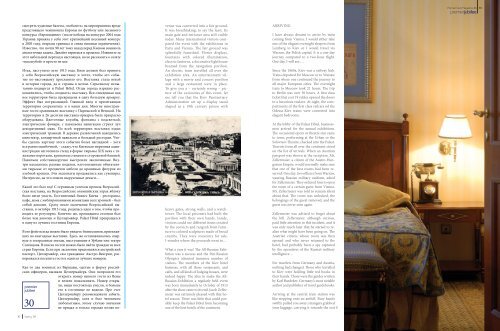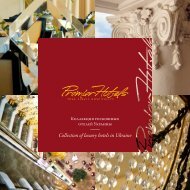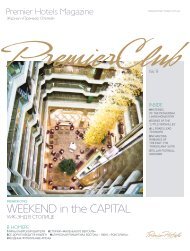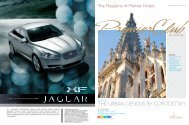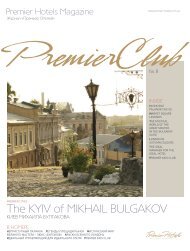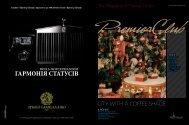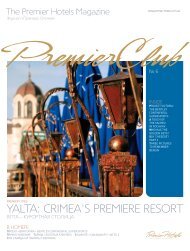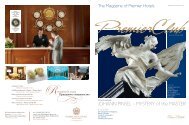PREMIER PALACE â CENTENARY IN STYLE
PREMIER PALACE â CENTENARY IN STYLE
PREMIER PALACE â CENTENARY IN STYLE
Create successful ePaper yourself
Turn your PDF publications into a flip-book with our unique Google optimized e-Paper software.
Premier Club Magazine #4 31<br />
premierjubilee<br />
смотреть чудесные балеты, «поболеть» на мероприятиях вроде<br />
предстоящего чемпионата Европы по футболу или песенного<br />
конкурса «Евровидение» (после победы на конкурсе 2004 года<br />
Украина приняла у себя этот крупнейший песенный конкурс<br />
в 2005 году, открыла границы и сняла визовые ограничения).<br />
Известно, что почти 90 лет тому назад перед Киевом возникла<br />
аналогичная задача. Давайте вернемся в прошлое. Извините за<br />
этот небольшой переход в настоящее, но не рассказать о салате<br />
«под шубой» я просто не мог.<br />
Итак, наступило лето 1913 года. Киев должен был принять<br />
у себя Всероссийскую выставку и хотел, чтобы это событие<br />
по-настоящему прославило его. Выставка стала вехой<br />
в истории города, да и страны в целом. Серьезному испытанию<br />
подвергся и Palast Hôtel. Отцы города изрядно раскошелились,<br />
чтобы «поднять» выставку. Вся отведенная под<br />
нее территория была превращена в одну большую ярмарку.<br />
Эффект был потрясающий. Главный вход и прилегающая<br />
территория сохранились и в наши дни. Многие иностранные<br />
гости сравнивали выставку с Парижской и Венской. На<br />
территории в 26 десятин выставка-ярмарка была прекрасно<br />
оборудована. Цветочные клумбы, фонтаны с подсветкой,<br />
электрические фонари, с павильона навигации струил луч<br />
декоративный маяк. По всей территории выставки ездил<br />
электрический трамвай. В деревне развлечений находились<br />
кинотеатр, концертный павильон и большой ресторан. Чтобы<br />
сделать картину этого события более наглядной – хотя<br />
все равно ошибочной, – скажу, что Киевская тюремная администрация<br />
изготовила стенд в форме тюрьмы ХIХ века с тяжелыми<br />
воротами, крепкими стенами и сторожевой башней.<br />
Павильон собственноручно выстроили заключенные. Внутри<br />
находились разные поделки, изготовленные обитателями<br />
тюрьмы: от предметов мебели до крашеных фигурок из<br />
хлебной крошки. Эти экспонаты продавались как сувениры.<br />
Интересно, на что пошли вырученные деньги…<br />
Какой это был год! С огромным успехом прошла Всероссийская<br />
выставка, на Всероссийских олимпийских играх яблоку<br />
было негде упасть. Гостиничный бизнес Киева – рестораны,<br />
кафе, дома с меблированными комнатами всех уровней – был<br />
собой доволен. Сразу после окончания Всероссийской выставки,<br />
в октябре 1913 года, родилась идея о том, чтобы проводить<br />
ее регулярно. Конечно же, прошедшим сезоном был<br />
более чем доволен и Целлермайер. Palast Hôtel превращался<br />
в одну из лучших гостиниц Европы.<br />
В его фойе всегда можно было увидеть бизнесменов, приезжавших<br />
на ежегодные выставки. Здесь же останавливались оперные<br />
и театральные звезды, выступавшие в Урбане или театре<br />
Соловцова. В списке гостей можно было найти граждан из всех<br />
стран Европы. Если при заселении предъявлялся австрийский<br />
паспорт, Целлермайер, сам гражданин Австро-Венгрии, распоряжался<br />
поселить гостя в один из лучших номеров.<br />
premier<br />
jubilee<br />
30<br />
Как-то два военных из Варшавы, одетые в форму российских<br />
офицеров, вызвали Целлермайера. Они попросили его<br />
открыть номер некоего гостя из Вены<br />
и велели помалкивать. Номер открыли,<br />
вещи постояльца унесли, и больше<br />
его в гостинице не видели. Про счет<br />
Целлермайеру рекомендовали забыть.<br />
Целлермайер, хотя и был человеком<br />
любопытным, этому случаю значения<br />
не придал и только гораздо позже по-<br />
venue was converted into a fair ground.<br />
It was breathtaking, to say the least. Its<br />
main gate and entrance area still visible<br />
today. Many international visitors compared<br />
the event with the exhibitions in<br />
Paris and Vienna. The fair ground was<br />
splendidly furnished. Flower displays,<br />
fountains with colored illumination,<br />
electric lanterns, a decorative lighthouse<br />
beamed from the navigation pavilion.<br />
An electric tram travelled all over the<br />
exhibition area. An entertainment village<br />
with a movie and concert pavilion<br />
and a large restaurant were in place.<br />
To give you a – certainly wrong – picture<br />
of the curiosities of this event, let<br />
me tell you that the Kiev Penitentiary<br />
Administration set up a display stand<br />
shaped as a 19th century prison with<br />
heavy gates, strong walls, and a watchtower.<br />
The local prisoners had built the<br />
pavilion with their own hands. Inside,<br />
visitors could see different items created<br />
by the convicts and ranginh from furniture<br />
to colored sculptures made of bread<br />
crumbs. They were souvenirs for sale.<br />
I wonder where the proceeds went to…<br />
What a year it was! The All-Russian Exhibition<br />
was a success and the Pan-Russian<br />
Olympics attracted immense number of<br />
visitors. The members of the Kiev hotel<br />
business, with all those restaurants, and<br />
cafés, and all kinds of lodging houses, were<br />
indeed happy. The idea to make the All-<br />
Russian-Exhibition a regularly held event<br />
was born immediately in October of 1913<br />
after the show came to its end. Jacob Zellermeier<br />
was extremely pleased with that hotel<br />
season. There was little that could possibly<br />
keep the Palast Hôtel from becoming<br />
one of the best hotels of the continent.<br />
ARRIV<strong>IN</strong>G<br />
I have always dreamt to arrive by train<br />
coming from Vienna. I would either take<br />
one of the elegant overnight sleepers from<br />
Lemberg to Kiev or I would travel via<br />
Warsaw, the Polish capital. It is a one-day<br />
journey compared to a two-hour flight.<br />
One day, I will see …<br />
Since the 1860s, Kiev was a railway hub.<br />
Trains departed for Moscow or to Warsaw<br />
from where one continued the journey to<br />
all major European cities. The overnight<br />
train to Moscow took 21 hours. The trip<br />
to Berlin was over 30 hours. A first class<br />
ticket that cost 19 rubles opened the doors<br />
to a luxurious enclave. At night, the compartments<br />
of the first class railcars od the<br />
Odessa-Kiev trains were converted into<br />
elegant bedrooms.<br />
At the lobby of the Palast Hôtel, businessmen<br />
arrived for the annual exhibitions.<br />
The occasional opera or theatre star came<br />
to town, performing at the Urban or the<br />
Solovtsov Theatre, checked into the Palast.<br />
Tourists from all over the continent stood<br />
on the list of arrivals. When an Austrian<br />
passport was shown at the reception, Mr.<br />
Zellermaier, a citizen of the Austro-Hungarian<br />
Empire, would normally make sure<br />
that one of the best rooms had been reserved.<br />
One day, two officers from Warsaw,<br />
wearing Russian military uniform, asked<br />
for Zellermeier. They ordered him to open<br />
the room of a certain guest from Vienna.<br />
Mr. Zellermeier was told to remain silent<br />
about that. The room was unlocked, the<br />
belongings of the guest removed, and the<br />
guest was never seen again.<br />
Zellermeier was advised to forget about<br />
the bill. Zellermeier, although curious,<br />
paid little attention to this incident, and it<br />
was only much later that he started to realize<br />
what might have been going on. The<br />
Austrian citizen, whose room was then<br />
opened and who never returned to the<br />
hotel, had probably been a spy captured<br />
by the operatives of the Russia’s military<br />
intelligence…<br />
For travelers from Germany and Austria,<br />
nothing had changed. Those who travelled<br />
to Kiev were holding little red books in<br />
their hands. Those were the guides written<br />
by Karl Baedeker, Germany’s most notable<br />
author and publisher of travel guidebooks.<br />
Arriving at the central train station was<br />
like stepping onto an anthill. Busy hands<br />
swiftly pulled you away; strangers grabbed<br />
your luggage, carrying it towards the exit<br />
30 Spring ‘09


